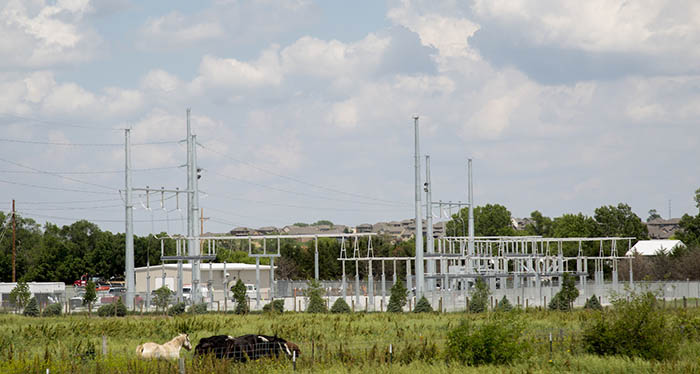What does a substation do?

Between OPPD’s generating stations and your home is a big, gray, industrial-looking facility with many vital jobs.
Substations help ensure the safe, efficient flow of electricity throughout eastern Nebraska. OPPD operates about 130 of the estimated 55,000 substations nationwide.
Here’s how they work.
The right voltage
To send large amounts of electricity safely and efficiently over long distances, OPPD relies on high-voltage transmission lines. Voltage is essentially the pressure that moves electrical current through OPPD’s power lines and your home.
At lower voltages, electricity doesn’t travel as easily, and more energy is lost via heat that escapes from the wires. OPPD would need more lines to transmit the same amount of power, at a greater cost. But the higher voltage in transmission lines is too much for any typical home or small business to handle.
Enter substations. Before electricity flows from generating stations to the smaller, local distribution lines that feed your home, it passes through a substation transformer.
The transformer is a large box with two adjacent coils of wire inside. Electricity flows into the first coil, known as an inductor. The winding wire resists the flow of electrical current, trapping some of the energy and creating an invisible magnetic field that extends outside of the wire coil.
Even though the coils aren’t physically touching, the energy in the first coil’s magnetic field induces a voltage through the second coil (also an inductor).
Why do this?
The voltage from Coil 1 to Coil 2 changes based on the number of loops in each one. If Coil 1 (the transmission side) has 1,000 loops and Coil 2 has 100 loops, the voltage on Coil 2 will be 10 times lower, and vice versa.
Voltage (volts) times current (amperes) equals power (watts). So, when the voltage rises, current drops proportionally and the total power stays the same, minus some small losses. Think of it as a car’s transmission, shifting between higher and lower gears to change the amount of torque delivered to the wheels.
This allows transformers to increase (step up) voltage for easier long-distance transmission across eastern Nebraska. Or they can decrease (step down) voltage so that electricity can flow safely into the neighborhood distribution lines that supply power to your home.
A modern twist
Substations date all the way back to the late 1800s, but modern models can do a lot more than their predecessors.
Today’s subs feature protection and control relays that act like a brain. They collect information from the grid and share it remotely with OPPD’s Energy Control Center. If relays detect a problem, such as a short-circuit or overload, they engage the substation breakers to interrupt the flow of electricity and isolate the problem. That reroutes power to minimize the area and duration of any outages.
Substation breakers also help crews with maintenance by isolating certain areas for work without interrupting the flow of electricity to the rest of the system.
Safety
As always, substations are designed with safety in mind. A fence surrounds the perimeter. Energized equipment is mounted above the ground at safe heights according to voltage level. And insulated cable is buried at safe depths. Equipment in substations can pose a deadly shock risk to anyone who isn’t properly trained and equipped with protective gear.
Many design features safeguard both workers and equipment.
Every substation is built on a base of gravel, which makes it more difficult for errant voltage to travel through the ground and shock someone.
Lightning arresters protect equipment from damage by providing a path for lightning’s current to flow to the ground. And circuit breakers interrupt unusually high currents before they can damage infrastructure.

Grant Schulte joined OPPD as a content generalist in 2022. He is a former reporter for The Associated Press, where he covered the Nebraska Legislature, state politics and other news for a global audience. He is a graduate of the University of Iowa and a proud Hawkeye. In his free time he enjoys running, reading, spending time with his wife, and all things aviation.
View all posts by Grant Schulte >







